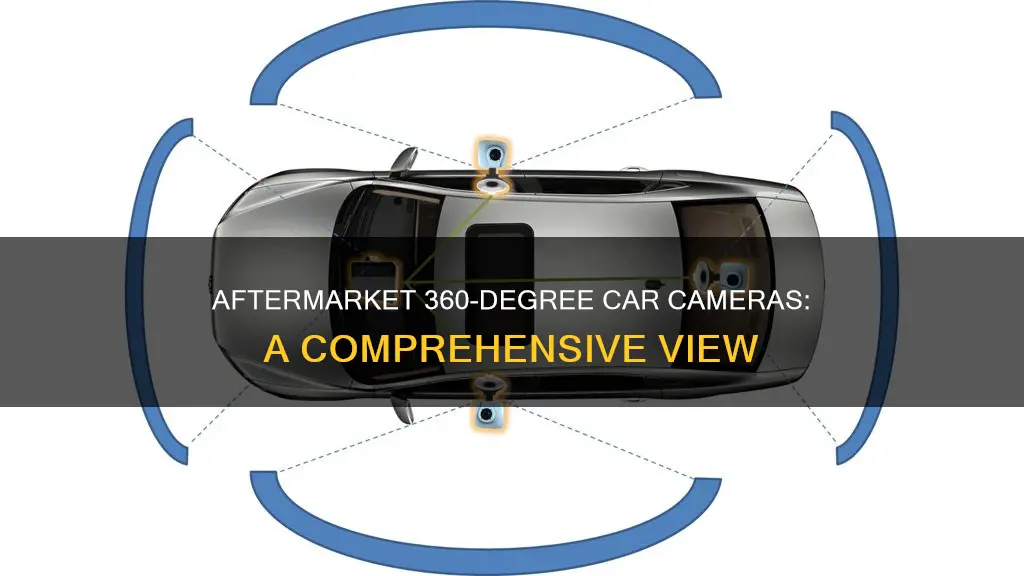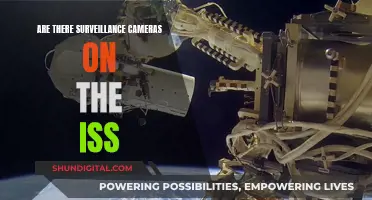
Adding a 360-degree camera to your car is a smart upgrade that can improve visibility and enhance your driving experience. These cameras can help with parking, manoeuvring in tight spaces, and removing blind spots. You can choose between a 2D or 3D system, with prices for aftermarket kits ranging from $200 to $900. Installation can be complex and time-consuming, especially for longer vehicles, and may require professional help.
| Characteristics | Values |
|---|---|
| Number of cameras | 4-6 |
| Camera placement | Front and rear bumpers, beneath side mirrors, occasionally on the roof |
| Camera features | Wide-angle lenses, night vision, water resistance |
| Software features | Stitching of images, dynamic guidelines, moving object recognition, blind spot monitoring, recording capabilities |
| Display | Infotainment screen or a separate monitor |
| Cost | $200-$900 for the kit, $300-$500 for installation |
What You'll Learn
- Aftermarket 360-degree cameras can cost between $200 and $900
- Installation can cost an additional $300 to $500
- It's possible to install the camera yourself, but it requires careful planning, measuring, and calibration
- degree cameras are particularly useful for parking and manoeuvring in tight spaces
- They can also be used to record footage when the car is parked

Aftermarket 360-degree cameras can cost between $200 and $900
Aftermarket 360-degree cameras are available for purchase and installation in your car. However, it is important to note that they may not perform as well as factory-installed systems, as those are specifically engineered for each car model.
When choosing an aftermarket 360-degree camera system, consider the compatibility, quality, and functionality of the system. Ensure that the system is compatible with your car's make, model, and features, and check if it can function with your current infotainment screen or if a separate monitor is needed. Look for high-quality cameras with features like wide-angle lenses, excellent resolution, night vision, and water resistance. Some systems may offer additional features like dynamic gridlines, moving object recognition, and blind spot monitoring, so choose the features that are most important to you.
Overall, a 360-degree camera system can be a practical and valuable feature for your car, improving safety, convenience, and the driving experience.
The Many Names of Computer Cameras
You may want to see also

Installation can cost an additional $300 to $500
Installation Costs for Aftermarket 360-Degree Cameras
Aftermarket 360-degree camera kits for cars are available, but they may not perform as well as a factory-installed system. The cost of these kits varies, ranging from $200 to $900, and that's just for the hardware. If you opt to have a professional handle the installation, you can expect to pay an additional $300 to $500 in labour costs.
The installation process is more intricate than simply affixing cameras to your vehicle and linking them to a control unit. It requires careful calibration and positioning of the cameras, involving a significant amount of planning, measuring, and fine-tuning to ensure optimal performance.
For longer vehicles, such as RVs, the installation process becomes more complex, and the total installation time and costs will likely increase.
While it is possible to install an aftermarket 360-degree camera system yourself, it is important to ensure that you have the necessary tools and a spacious area to work in.
Factors Affecting Installation Costs
The cost of installing a 360-degree camera system can vary depending on several factors:
- Vehicle make and model: The cost of installation can differ based on the specific vehicle. Some cars may be prewired and have features that make them more adaptable to aftermarket installations, resulting in lower installation prices. In contrast, luxury vehicles or cars with complex electrical systems might require more work, pushing the cost higher.
- Integration with existing systems: Integrating the 360-degree camera with your car's infotainment screen and power source can add complexity and expense to the installation process.
- Camera quality and features: The price of the camera system itself can range from $300 to $1,200, depending on factors such as camera quality, resolution, and additional features like night vision or motion sensors.
Benefits of a 360-Degree Camera System
Despite the potential costs, a 360-degree camera system offers significant advantages:
- Improved visibility and safety: The system provides a bird's-eye view of your vehicle and its surroundings, making parking and manoeuvring in tight spaces easier and safer.
- Reduced blind spots: The multiple cameras help eliminate blind spots, allowing you to monitor your surroundings effectively and alert you to obstacles that mirrors alone might miss.
- Enhanced security: The cameras can also serve as a security measure, providing a comprehensive view around your vehicle and capturing footage before and after any movement is detected.
Alternative Options
If you are hesitant about the costs of a 360-degree camera system, there are alternative options to consider:
- Factory-installed systems: While aftermarket systems offer flexibility, factory-installed 360-degree camera systems benefit from being tailored to specific models, ensuring optimal performance and seamless integration.
- Basic aftermarket kits: Basic aftermarket kits starting from $100 to $200 can be a more cost-effective option, but they may not offer the same level of performance and features as higher-end systems.
- Standard backup cameras and parking sensors: For those on a tight budget, relying on a standard backup camera, parking sensors, or honing your parking skills can be a viable alternative to investing in a 360-degree camera system.
In conclusion, while the installation of an aftermarket 360-degree camera system can incur additional costs of $300 to $500, the benefits of improved visibility, safety, and security may outweigh the financial burden for those seeking to enhance their driving experience.
Marco Mode: Panasonic Camera's Secret Superpower
You may want to see also

It's possible to install the camera yourself, but it requires careful planning, measuring, and calibration
Installing a 360-degree camera system in your car can be a great way to enhance your driving experience and safety. While it is possible to install a 360-degree camera system yourself, it requires careful planning, measuring, and calibration. Here are some important things to consider:
- Camera Placement: The cameras need to be carefully placed at specific points on the vehicle, such as the front grille, side-view mirrors, and above the license plate. This ensures that you get a complete 360-degree view of your surroundings.
- Calibration: Proper calibration of the cameras is crucial for the system to function accurately. You will need to adjust and fine-tune the cameras to ensure they are correctly aligned and provide a seamless, coherent image.
- Measuring and Aiming: Correctly aiming and positioning the cameras is essential. This may involve a fair amount of measuring and fine-tuning to ensure the cameras capture the necessary fields of view.
- Technical Knowledge: Installing a 360-degree camera system requires a good understanding of the technology. You will need to know how to connect the cameras to the control unit and your vehicle's infotainment screen.
- Tools and Space: Make sure you have the right tools and a spacious area to work in. Installation can be complex, especially if you need to drill holes or route cables.
While it is possible to install a 360-degree camera system yourself, it is important to recognise that it is a complex process that requires careful planning and technical knowledge. If you feel unsure about any aspect of the installation, it may be best to consult a professional or seek advice from experts.
Focusing Night Owl HD Cameras: Tips and Tricks
You may want to see also

360-degree cameras are particularly useful for parking and manoeuvring in tight spaces
360-degree cameras are a valuable safety feature, particularly useful for parking and manoeuvring in tight spaces. They provide a bird's-eye view or top-down perspective of your vehicle and its surroundings, making it easier to navigate into a narrow parking spot or a confined area. This is especially helpful when driving larger vehicles like RVs or trucks, where visibility can be limited.
The system combines footage from multiple cameras positioned around the vehicle, typically including the front grille, side mirrors, and above the license plate. This allows drivers to see any obstacles nearby and correct their course, reducing the risk of low-speed impacts like scraping a wheel or bumping into an object. The split-screen view, which includes both the rearview and surround-view images, is especially handy when parallel parking or pulling into a tight parking space.
While some newer vehicles have built-in 360-degree camera systems, there are also aftermarket kits available for purchase. These kits typically include multiple cameras and a controller to link them to your infotainment screen. However, it's important to note that aftermarket installations may not perform as seamlessly as factory-installed systems due to differences in camera placement and integration.
Overall, 360-degree cameras offer enhanced visibility and safety when parking and manoeuvring, helping to prevent minor accidents and making driving in tight spaces a less stressful experience.
Police Arrest in Caught-on-Camera Heist
You may want to see also

They can also be used to record footage when the car is parked
360-degree cameras are an increasingly popular feature in cars, offering drivers a bird's-eye view of their vehicle and its surroundings. While they are particularly useful for parking and manoeuvring in tight spaces, they can also be used to record footage when the car is parked, providing valuable security and peace of mind.
Aftermarket 360-degree camera kits are available for those who want to add this feature to their existing vehicle. These kits typically include four cameras that can be mounted on the car body, as well as a control box and cables. Some kits may also include a display screen or remote control. The cameras are usually placed on the front and rear bumpers, and on the side mirrors, to provide a comprehensive view of the car's surroundings.
One of the benefits of a 360-degree camera system is that it can record footage even when the car is parked, providing a valuable security measure. This can be especially useful if your car is parked in an area without adequate security or if you have experienced vandalism in the past. The cameras can be set up to start recording when motion is detected, and some systems will notify you via your mobile phone if someone is tampering with your vehicle. This allows you to quickly review the footage and take appropriate action.
In addition to security, a 360-degree camera system can also provide valuable evidence in the event of an accident or insurance claim. The footage can help determine what happened and who was at fault, protecting you from false accusations or fraudulent claims.
It's important to note that while aftermarket 360-degree camera systems can be a great addition to your vehicle, they may not perform as well as factory-installed systems. The positioning and calibration of the cameras are crucial for proper functionality, and it can be a complex process to get everything working optimally. Professional installation is recommended to ensure the best results.
Annke Cameras: Where Are They Manufactured?
You may want to see also
Frequently asked questions
A 360-degree camera system in a car provides a real-time view of the area surrounding your car. It combines the perspectives of several video cameras placed around the vehicle into one image, typically a top-down view.
A 360-degree camera system usually has four wide-angle cameras integrated into the car body panels. One camera is in the middle of the front grille, two more ultra-wide-angle cameras look down from the side-view/wing mirrors, and a fourth is just above the license plate. While a minimum of four cameras can form a 360-degree view, some cars may have eight or nine cameras.
Yes, there are aftermarket 360-degree camera kits available for purchase and installation. These kits typically include four cameras and a controller that links them to your car's infotainment screen.







